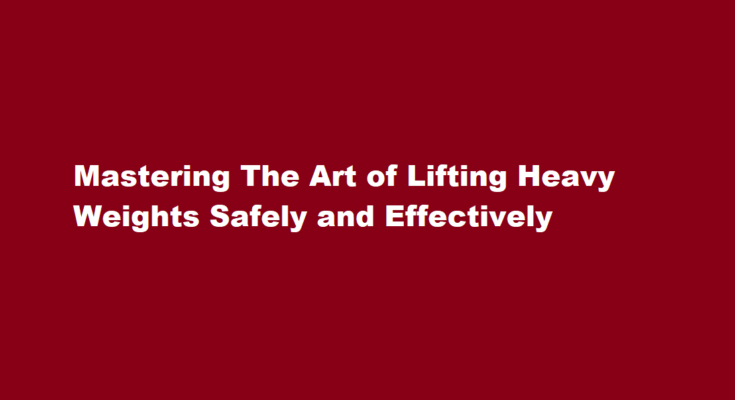When it comes to strength training, lifting heavy weights can provide a challenging and rewarding experience. However, it’s crucial to approach this endeavor with caution and proper technique to prevent injury and maximize gains. In this article, we will delve into the essential guidelines for lifting heavy weights safely and effectively.
Prioritize Proper Form
Before attempting to lift heavy weights, mastering proper form is paramount. Incorrect form not only increases the risk of injury but also diminishes the effectiveness of your workout. Start with lighter weights to practice your form and gradually progress to heavier loads. Engage your core, maintain a neutral spine, and focus on controlled, fluid movements.
Warm Up Thoroughly
A thorough warm-up is essential to prepare your muscles, joints, and central nervous system for heavy lifting. Engage in dynamic stretches, light cardio, and mobility exercises to increase blood flow and improve flexibility. A warmed-up body is more responsive and less prone to strains and tears.
Progress Gradually
Progression is key to successful weightlifting. Gradually increase the weight you lift to challenge your muscles without overexerting them. A good rule of thumb is to aim for a weight that allows you to perform 6 to 8 repetitions with proper form before muscle fatigue sets in.
Focus on Compound Movements
Compound movements, such as squats, deadlifts, bench presses, and overhead presses, engage multiple muscle groups simultaneously. These exercises not only build overall strength but also enhance muscle coordination and stability. Incorporating compound movements into your routine will provide a solid foundation for lifting heavier weights.
Implement Proper Breathing Techniques
Breathing plays a crucial role in weightlifting. Inhale deeply before starting the movement, and exhale forcefully as you exert force. This practice stabilizes your core and supports your spine, reducing the risk of injury. Maintain a consistent breathing rhythm throughout each repetition.
Use Proper Equipment
Utilizing appropriate equipment can significantly enhance your lifting experience. Invest in quality lifting shoes, lifting belts, wrist wraps, and knee sleeves to provide support and stability to the joints most vulnerable during heavy lifting. However, remember that these tools are meant to supplement proper form, not replace it.
Get Adequate Rest
Muscles need time to recover and grow stronger after intense workouts. Adequate rest between lifting sessions is vital. Aim for at least 48 hours of rest for each muscle group before working it again. This rest allows your muscles to repair and adapt, leading to better gains and reduced risk of overuse injuries.
Listen to Your Body
Understanding your body’s signals is essential when lifting heavy weights. Distinguish between muscle fatigue and pain – pushing through fatigue is part of effective training, but pushing through pain can lead to injury. If something feels off or painful, stop immediately and assess the situation.
Stay Hydrated and Nourished
Proper hydration and nutrition are often underestimated aspects of weightlifting. Hydration supports muscle function and joint lubrication, while adequate nutrition fuels your body for optimal performance. Consume a balanced diet rich in protein, complex carbohydrates, healthy fats, and vitamins to support your training goals.
Incorporate Recovery Techniques
Integrate recovery techniques into your routine to prevent overtraining and ensure long-term success. Stretching, foam rolling, and massage therapy can aid in muscle recovery and flexibility. Additionally, consider practices like yoga and meditation to promote mental relaxation and stress reduction.
Consult a Professional
If you’re new to lifting heavy weights or have any existing medical conditions, seeking guidance from a certified fitness professional is wise. They can design a personalized program that aligns with your goals and abilities while ensuring your safety.
FREQUENTLY ASKED QUESTIONS
Is 20Kg heavy to lift?
20Kg dumbbells are more than enough for most beginners. In fact 10kg dumbbells will probably be enough because there are so many exercises. But honestly, just get membership at a gym and separate your days for different muscles you are training. Make sure squats and deadlifts are done once a week.
How do I start lifting heavy weights at home?
Make sure you warm up before you lift AND cool down after each sesh. Start with lighter weights and increase weight gradually. Perfect your form before you start. Rest for at least 1 minute between sets and limit workouts to 45 minutes, tops.
In conclusion, lifting heavy weights can be immensely rewarding for your strength and physique, but safety and technique should always be prioritized. By focusing on proper form, gradual progression, and overall well-being, you can embark on a journey of successful heavy lifting without compromising your health. Remember that consistency, patience, and dedication are the cornerstones of achieving your desired results while minimizing the risk of injury.
Read Also : Elevating Your Mood Science-Backed Strategies for a Brighter You



